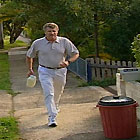The Federal Government has recently released some National Physical Activity Guidelines, which refer to the minimum levels of physical activity required for good health. The first guideline encourages us to ‘think of movement as an opportunity, not an inconvenience’. This basically means trying to recover the level of movement that humans used to carry out before the advent of machines and technology.
Garry Egger decided to put this guideline to the test. He conducted an experiment over 2 days, wearing a device called a pedometer on his belt. Pedometers measure the number of steps that you take during the day. The average person walks two to three thousand steps a day, only about a third or a quarter of the seven and a half thousand steps required. Garry weighs about 80 kilos, so for every 25 steps he takes he burns roughly 1 calorie.
Lazy day
Garry spent day one thinking of movement as an inconvenience. He tried to avoid moving by using every bit of technology at his disposal. So he did things like driving to the shop to buy milk instead of walking, using the remote control on the TV rather than getting up to change channels, taking the escalators instead of the stairs and using a dishwasher instead of washing up by hand.
At the end of the day the pedometer showed that Garry had only taken about 4,000 steps. That’s about 120 calories, or the equivalent of a few beers.
Active Day
On day two Garry tried to live by the Government’s physical activity guideline, and think of all movement as an opportunity. He did things like walking to the shop for the milk instead of driving, using the stairs instead of the lift, making his own coffee instead of asking someone else to make it for him, getting up to change the TV channel and washing the dishes by hand.
On day two Garry clocked up nearly 9,000 steps on the pedometer, or 5000 more than he did on day one. Although 5,000 extra steps does not sound like much, it is equivalent to about 200 calories per day. This could amount to about half a kilo of fat every 2.5 weeks, or around 20 kilos per year.
Garry’s conclusion
Simply changing our attitudes to physical activity could help us become more active and could help solve the major problem of obesity that we have in Australia today. If you ‘think of movement as an opportunity, not an inconvenience’ it could be good for your health!
Further information
Pedometers can be purchased from sports stores or electronic stores for around $50.
For more information about the government guidelines visit: http://www.health.nsw.gov.au/public-health/health-promotion/improve/physicalactivity/pa_new/pa_gen/guide.htm



